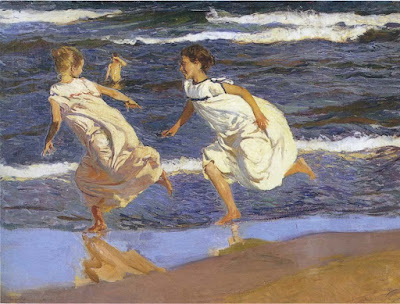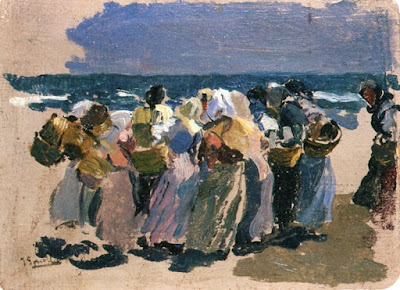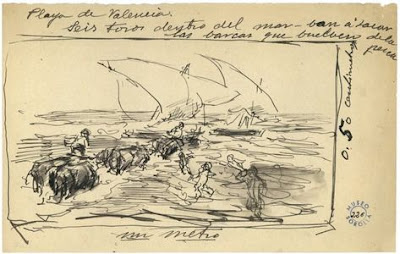Saturday, December 31, 2022
Caligula's Ships
Friday, December 30, 2022
What Did the Great Composers Really Look Like?
Hadi Karimi used digital tools to imagine what classical composers might have looked like. He says:
"Beethoven is often portrayed as this heroic figure that resembles more of a Greek god than a human who dedicated his life to music. To reconstruct his face I only used his LIFE mask and also a bust that was made by the same person who made the mask. He also had a death mask, but due to his illness, he lost so much weight that the mask is almost useless for this purpose.
"Sculpted in ZBrush, the color texture was painted in Substance Painter, rendered in Maya with Arnold, used Xgen core for the hair."
Thursday, December 29, 2022
Sky is the Lightest
Vlaho Bukovac (Croatian, 1855-1922) said: "In nature, the sky is the lightest thing of all."
Monday, December 26, 2022
How Fleischer Studios Made Cartoons
In 1938, Fleischer Studios produced this short documentary showing how they made animated cartoons.
The Florida-based studio that popularized Popeye and Betty Boop resembled the Disney process in using painted cels, but there were important differences, too. Fleischer innovated the rotating 3D backgrounds, and they typically recorded the character voices after the animation was completed.
At the YouTube channel Fabulous Fleischer Cartoons Restored they've got a lot of beautifully restored cartoons, and the Tested channel explored how the restoration process works.
Saturday, December 24, 2022
Santa Claus Print
My first idea was to paint Santa heroically standing on a rooftop next to a chimney with the elves showing him a map of the route.
Then I tried a bunch of other ideas, including supervising the elves' workshop and flying over the rooftops in his sleigh.
I got our local hardware-store Santa, Harry Turra, to come over and pose in my studio. He arrived in costume and in character on a snowy night. My young sons were spellbound to meet the real Santa.
The rest of the props and setting were compiled from various homes and hotels here in my Hudson Valley hometown.
Thursday, December 22, 2022
Wednesday, December 21, 2022
What I've Been Thinking About Generative Art
Image generated by computer from a text prompt
The field of text-to-image generative art has been drawing investor dollars, and has been growing at an impressive pace, with lots of startups creating services using Stable Diffusion, Midjourney, Dall-E2 and ChatGPT. One notable investor newsletter called Antler has just released an introduction to the field and a map of what's out there.
My brief quote in the article is part of a longer Q and A that I did with the author. If you're interested in where my thoughts are at the moment, read on for the full interview, and I invite you to share your thoughts in the comments:
December 19, 2022
Thoughts about Generative AI or AI Art
Questions from Ollie Forsyth of Antler Investments
1. What impact does Generative AI have on you as a creator?
Not much. I've tried Dall-E2, Stable Diffusion, and ChatGPT but the results for me always fall too far short of what I have in mind to create. I have very specific ideas in mind when I want to make a picture, and I get the best results and the most satisfaction from making my pictures with paint and brushes. I have always made my art with physical tools, and use digital tools for photography and video to document the process and the results.That said, I'm watching what's happening with great interest. I'm truly inspired by the results other people are getting with the help of generative models. The people who consistently get the best results often have a computer coding background as well as an aesthetic sense. Is it “art?” Sure, why not? It definitely stimulates my imagination and the good stuff strikes me as original.
You often hear artists call AI image models as "tools," but AI is so much more than a tool. It's a creative partner, a synthetic genie, or an inspirational ally. It’s a weird feeling to acknowledge that a machine can be an able creative partner, with the human acting as a kind of midwife or helping.
But I'm 100% old school. For me, imagination is a basic human process, like eating or walking. I don't think I would feel fully human if I had to rely on such a system as a creative partner.
Is this a good thing or is it going to have a negative impact on creators?
There's a lot of good about generative AI in art. For one thing, there has been a huge surge in appreciation for surrealism and fantasy, because that's what it does best. I've seen a lot of images that are new and exciting. The potentials of the medium are almost limitless. But it’s also scary and threatening, especially to digital artists who are part of corporate entertainment pipelines, such as concept artists.Many artists are concerned about Generative AI “scraping” copyrighted images in their training data. Others worry about it displacing artists. Some people are trying to stop it, or at least shape it.
I'm not worried about either of those issues because AI art for the most part alters and transforms its source material, just as humans do. An artist’s style can’t and shouldn’t be copyrightable.
I don’t feel threatened by AI Art. There's no way it can take away my livelihood because of where I'm positioned as a painter in gouache. Mostly what I do is share behind-the-scenes demos of plein-air sketching on YouTube. No way can AI ever replace that.
I've been in the art business for almost 45 years, through a lot of technological changes. My career has had plenty of highs and lows during that span and I've had to reinvent myself several times. I am concerned not only for emerging artists, but also most all digital artists (top of their game or not, it doesn't matter).
What I try to keep in mind is that AI represents both a threat and an opportunity. If we only focus only on the threat, it may kill our career. If we focus on the opportunity we might end up doing fine.
I would caution the alarmists to remember that applying some sort of digital rights management mechanism could have a chilling effect on the growth of this new art form, and end up helping the powerful entertainment corporations more than the little guys.
Looking a little further down the road into the future, I don't see any easy way around the pitfalls of potential misinformation, deep-faking, erosion of shared reality, and content moderation. Should we let people use these systems to create whatever they want? Should we ask the generative models to edit “dangerous” ideas at the level of generation or distribution? Who defines what is dangerous? Should the government define the limits of what we're allowed to imagine or should private companies do so? China is passing new laws requiring watermarking all AI works. Should other countries do that? What are the political ramifications? These are big societal questions.
The biggest negative impact from my point of view is an erosion of human hand-eye skills and a weakening of the artist's confidence in his or her own imagination. Just as the industrial revolution and the invention of the motorcar made us lazier and less physically active, the development of push-button creativity and synthetic writing partners will make us stupider, and dull our ability to dream. These are core human values, and the threat is very real.
Those concerns were at the forefront of concerns among my YouTube followers:

2. What are your most pressing concerns about the platforms?
By "platforms" I assume you mean generative AI models, such as Midjourney, Dall-E 2, and Stable Diffusion. The ease of creating images means that there has been such a cascade of computer generated images and videos that they've glutted many arenas of the art world: portfolio sites, art print markets, contests, and freelance illustrators. This leads to a cheapening of all the images, a dulling of appreciation, and a confusion about what's really created by humans. How do you run an art school when the students can solve any assignment with the push of a button?
People who worry about the threat of AI art focus on the production side, but we shouldn't forget about the distribution side. How will people consume these images, films, and writing? Remember that the prompt doesn't have to come only from the artist, creator or director. It can also come directly from the consumer, acting as individuals or as fan groups.
Imagine an AI video-generator with personal biofeedback input that creates hallucinatory music or video to suit your current mood. Or let's suppose you have online groups who love Japanese anime style. Their preferences can shape the generation of every video they see. They can watch custom editions of their favorite media or games output with their favorite anime style. Or they can watch shorter or longer versions of films, or films customized for whatever language they speak.
If the viewer and the generative model drive the entire creative process, there's really no need for an "artist" or "director" at all. The idea that a work of art or film exists fixed in a single form at the moment of creation and then finds its audience may be a quaint idea that many of us will outgrow as a culture.
The other big concern is that all these models are based on existing, previously manifested styles of art and photography rather than on the direct human response to nature itself. Therefore it is, by definition, "mannerist." In terms of Plato's Allegory of the Cave, we're talking about the realm of firelit shadows in the cave wall, not the light of the sun itself. Maybe someone will invent ambulatory robots exploring the real world, but without such empirical input, this will always be a profound limitation.
3. How will you be using Generative AI platforms?
I won't condemn AI or vow never to use it, and I respect artists who choose to ally with computers to make art. This all didn't arrive out of the blue. Digital artists have been automating parts of their creative process for many years now, with 3D rendering, ray tracing, procedural effects, photobashing, etc. AI models have just moved the needle way beyond where it was.Now, for anyone to succeed with generative AI, there's no halfway. They need to join the arms race, learn coding, train their models, learn about the secretive alchemy of prompt writing, and cultivate their awareness of past art styles.
It's a very different path from painting, drawing, and animating with physical materials. We all have to make our peace with the digital sphere. Even classical musicians playing original instruments use digital recording techniques and social media, and read their music off iPads in concerts.
4. Where is all this headed? Please provide examples.
AI art draws upon the collective unconscious of human expression to generate something new. Laws will be passed and new businesses will be formed that will shape the evolution. We will come to enjoy art forms that we can't currently imagine. Those forms may take market share away from traditional forms, just as the introduction of television took away from magazines and movies.Because of the lack of friction to create these new art forms, there will be a lot of derivative junk out there. But let's assume we can develop algorithmic sorting techniques to allow the truly great stuff to surface. The art we'll see as a result of this technology will be surprising and fascinating. It will reflect many inputs: the prompter, the design of the generative model, the zeitgeist of the audience, and of the immensity of the dataset it draws from.
But as you think about generative computer models, don't forget that there's going to be a healthy backlash to the idea of handing off human creativity to computers. That cultural countermovement hasn't coalesced yet, but it will, and it will be powerful. What will this movement be called: the Human Agency? Hand-Eyes? H&H (Hearts and Hands)? Authentics? Analoggers? As David Sax has argued, the future is analog, or at least a healthy portion of it will be.
The invention of the internet a few decades ago was a boon for knitting and hand-lettering. In a similar way, the growth of AI and the decline of social media will be a powerful stimulus for such uber-traditional forms as face-to-face storytelling, on-location sketching, and recitation. Whatever it ends up being called, I plan to be part of that cultural countermovement.
--James Gurney
Tuesday, December 20, 2022
Memory of a Horse
Swedish wildlife painter Bruno Liljefors said that in order to be successful at painting animals, an artist must have:
1. A love of nature and animals.
2. Great powers of observation.
3. The memory of a horse.
That last note needs some explanation, because it may translate better as a "long, deep, memory."
Monday, December 19, 2022
Checkerboard Illusion
Why do the tones seem so different?
1. They have soft edges, and soft edges usually belong to shadows.
2. Those edges are parallel, and cast shadows from the sun on flat surface are parallel.
3. The tones of adjacent colored squares shift gradually in value to an equal degree, just the way shadows do.
Sunday, December 18, 2022
Scene in Sauropolis
Friday, December 16, 2022
Sorolla's Working Method

In the year 1904, Joaquín Sorolla (Spanish, 1863-1923) produced nearly 250 works, which included sketches and finished paintings.
"The execution of each work was preceded by a period of preparation in which, by means of several drawings or studies in color, whether of the whole or a detail, he tried to familiarize himself with the subject he wanted to represent with all the contrasts of light and color, with the proportions, form, and foreshortening of each figure and, finally, with the effects and the relationship of some tones with others.

"Once he had penetrated into all this, he placed his models in the right position and in the time and the light which the painting called for and he started working, without hesitation or changes.

"This is what gives his works painted out of doors their freshness, their spontaneity and their imponderable vigor of execution."
Quoted from the book Joaquin Sorolla by Blanca Pons Sorolla
Joaquín Sorolla (1863-1923) on Wikipedia
Thursday, December 15, 2022
The Animal Art of Caroline Clowes
Now there's a free exhibition of original art by Caroline Clowes on view at the Samuel Morse estate in Poughkeepsie, New York through December 30, 2022.
Here's a video with more information.
Tuesday, December 13, 2022
Birthday Pageant
| "Birthday Pageant" from the book Dinotopia: The World Beneath, Oil on canvas mounted to panel Birthday Pageant print |
Monday, December 12, 2022
A Helicopter in a Hurricane
What would it feel like for a helicopter to drop a boat into the sea during a raging storm?
Saturday, December 10, 2022
Rock 'n' Roll Santa
Thursday, December 8, 2022
USA Today Recommends Dinotopia

Signed copies shipped to USA addresses.
Wednesday, December 7, 2022
An Improvisational Approach
In 2020, at the height of the pandemic experience, I painted my wife shopping at the market.
The painting process was looser and more improvisational than usual.Tuesday, December 6, 2022
How Church Painted the Icebergs


Noble continues: “Again, the painter wipes his brushes, puts away his second picture, and tacks a fresh pasteboard within the cover of his box, and gives word to pull for the south-western side.”
Book: The Voyage of the Icebergs: Frederic Church's Arctic Masterpiece by Eleanor Jones Harvey
Monday, December 5, 2022
Midwinter Greetings
Sunday, December 4, 2022
Sarah, a Potter
Sarah, a potter, painted while she was working.
Saturday, December 3, 2022
Friday, December 2, 2022
Thursday, December 1, 2022
Bukovac and his Scraps of Paper
"While he was teaching his girls at home, at the table, Vlaho Bukovac (Croatian, 1855-1922) used every piece of paper, newspaper and book to make sketches on. When the last piece of paper in sight had been used up, Bukovac would calmly continue, drawing on the napkins, tablecloth, everything that was white and could take the mark of a pencil. He most of all hated to have to interrupt his work, even to the extent of having to get up and look for a piece of paper."
--
Vlaho Bukovac on Wikipedia
Quoted from the book Vlaho Bukovac: A Cosmopolitan Croatian









.jpg)




























